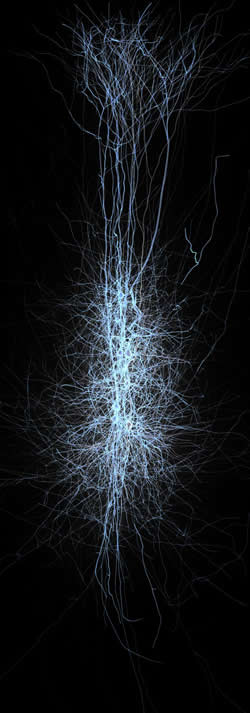Mapping the Human Brain with Supercomputers
by Henry Markram, Ph.D.

This image shows the reconstruction of a handful of brain cells. About half way up is the spherical somata, containing the cell nuclei. The network of branches allows extensive interconnection between even a few cells, which gives the human brain highly efficient, massively parallel processing power. Indeed, a simulation of a few thousand cells appears like a very dense jungle, in which individual cells are virtually indistinguishable. In this image, the short branches you can see clustered around the somata are dendrites and the long ones running up to the top of the image are axons. The vertical nature of the network of branches allows connections between brain cells located in different layers of the cerebral cortex.
The Human Brain Project (HBP) is working to unify our understanding of the human brain. We’re harnessing the power of supercomputers for problems we cannot solve with experiments alone—mapping the human brain and its diseases and using our map to develop even more powerful computers.
The potential of this work is highlighted by the fact that the HBP is funded by one of the largest scientific grants ever awarded by the European Commission. We bring together leading researchers in neuroscience, medicine and computing from 80 partner universities in the US, Canada, Europe and Asia.
Our main challenge is that the human brain is so extraordinarily complex that it’s very difficult to understand exactly how it’s put together and how it works. Each of our roughly 87 billion neurons is intricately connected to thousands of other neurons. Yet it is the precise arrangement of these connections, coupled with the sheer number of them, that gives us our unmatched mental abilities.
At the same time, it has never been more urgent for us to address the many health challenges related to problems of the brain. We are living longer lives than ever before, and that makes us more vulnerable to brain-related old age diseases such as Alzheimer’s, dementia and Parkinson’s.
Modern neuroscience is gathering more and more experimental data, but it still covers only a small fraction of the brain’s overall structure and functionality. The task is further complicated by the need to understand brains from males and females, different species, and healthy as well as sick individuals. In short, knowledge derived from experimental data still contains massive gaps, and we can’t accumulate new data quickly enough to transform this situation anytime soon, without some extra help.
This is where supercomputers come in. They allow us to construct and refine mathematical rules, derived from the limited experimental evidence we have, to predict with increasing accuracy the structure and functioning of sections of the brain.
As the power of supercomputers increases, we can predict and simulate larger parts of the brain, more accurately. By 2020, we should have supercomputers powerful enough to attempt an initial reconstruction of the structural and functional organization of the whole human brain. Ultimately, we hope to apply disease-specific rules to build models of brain diseases, allowing us to understand them better and to speed up the development of new medicines. At the same time, our vastly expanded insight into brain function will help transform information technology, paving the way for more efficient and flexible computers.
By using supercomputing power to leverage neuroscience data, we can turn mapping the human brain into a tractable problem, laying the foundations for a unified theory of brain function, as well as revolutionary applications in healthcare and computer technology.
Henry Markram (Director of the Blue Brain Project, Coordinator of the Human Brain Project and Professor of Neuroscience at the École Polytechnique Fédérale de Lausanne) will be a keynote speaker at The Academy of Medicine, Engineering & Science of Texas’ (TAMEST’s) Annual Conference, January 16-17, 2014. The conference will address the computational revolution in medicine, engineering, and science.

